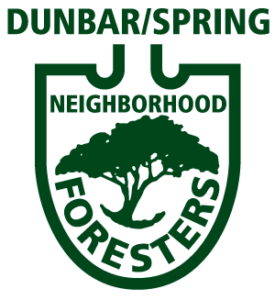by Brad Lancaster
The following are seven priorities of the Dunbar/Spring Neighborhood Foresters approach with its Neighborhood Rain, Tree, & Understory Plantings that are aligned with the Neighborhood Foresters Aims & Goals, and meant to lift the potential of our efforts, and hopefully inspire others to do likewise, or go further still…
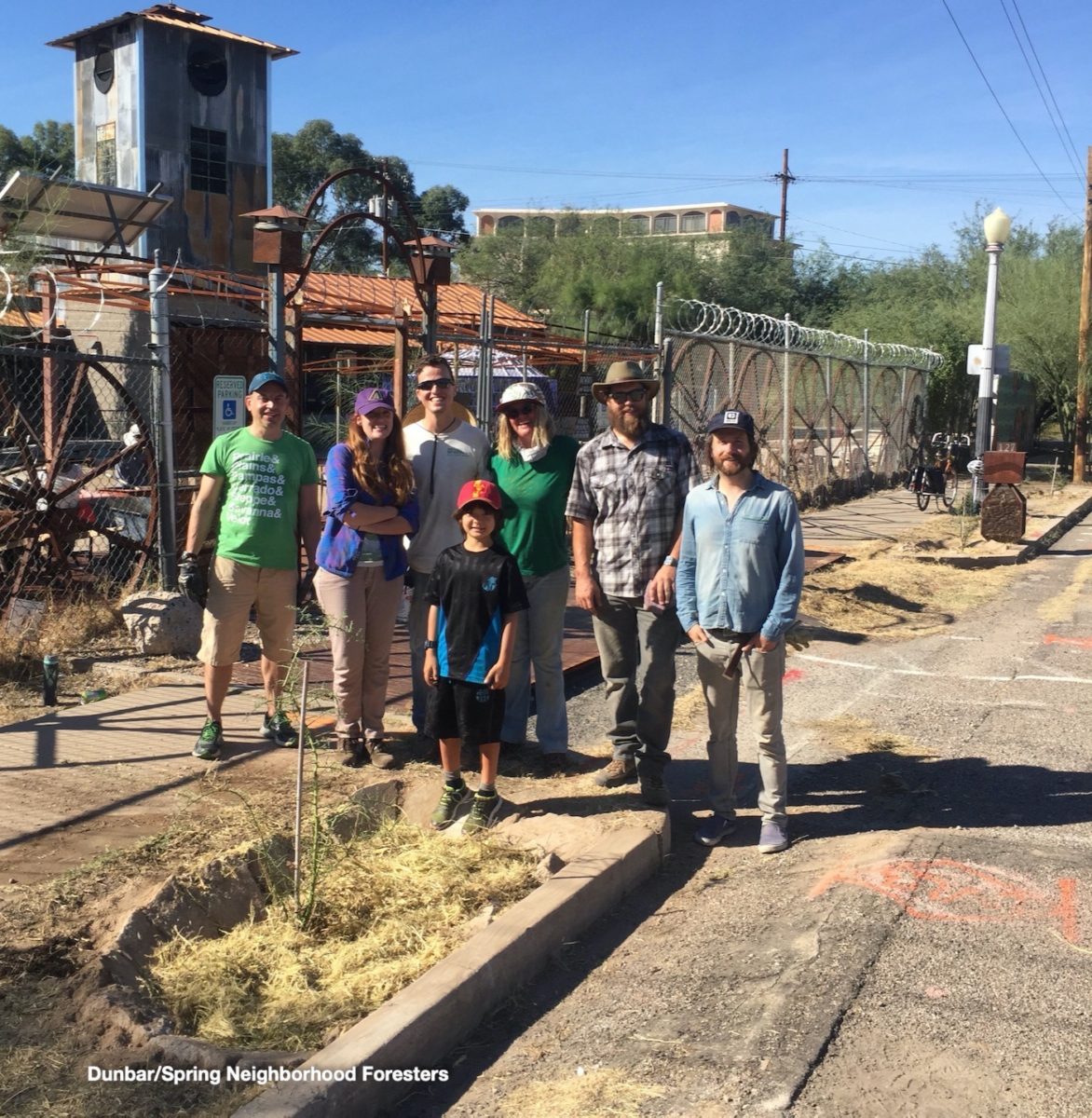
1. Enhancing the public commons
Neighborhood plantings of rain and vegetation in the public rights-of-ways is a great way to beautify and enhance the liveability of the neighborhood for everyone – homeowners, renters, visitors, and those just passing through.
That’s why the Neighborhood Foresters efforts focus on these public lands (along walkways & streets, in streets, around parks, throughout grounds of schools and places of worship, etc), rather than just private property.
2. Build community
The efforts also build community by inviting neighbors to better get to know one another by planting together, helping steward the plantings for many decades after the planting events, and informally meeting up as they enjoy the resulting forest. Any activity that gets neighbors spending more time in the neighborhood forest (such as plantings, prunings, picking up litter, harvesting foods and medicinals, bird watching, walking, bicycling, and hanging out on front porches) helps facilitate this meeting up. You can see how others do this by participating in another neighborhood’s forestry event.
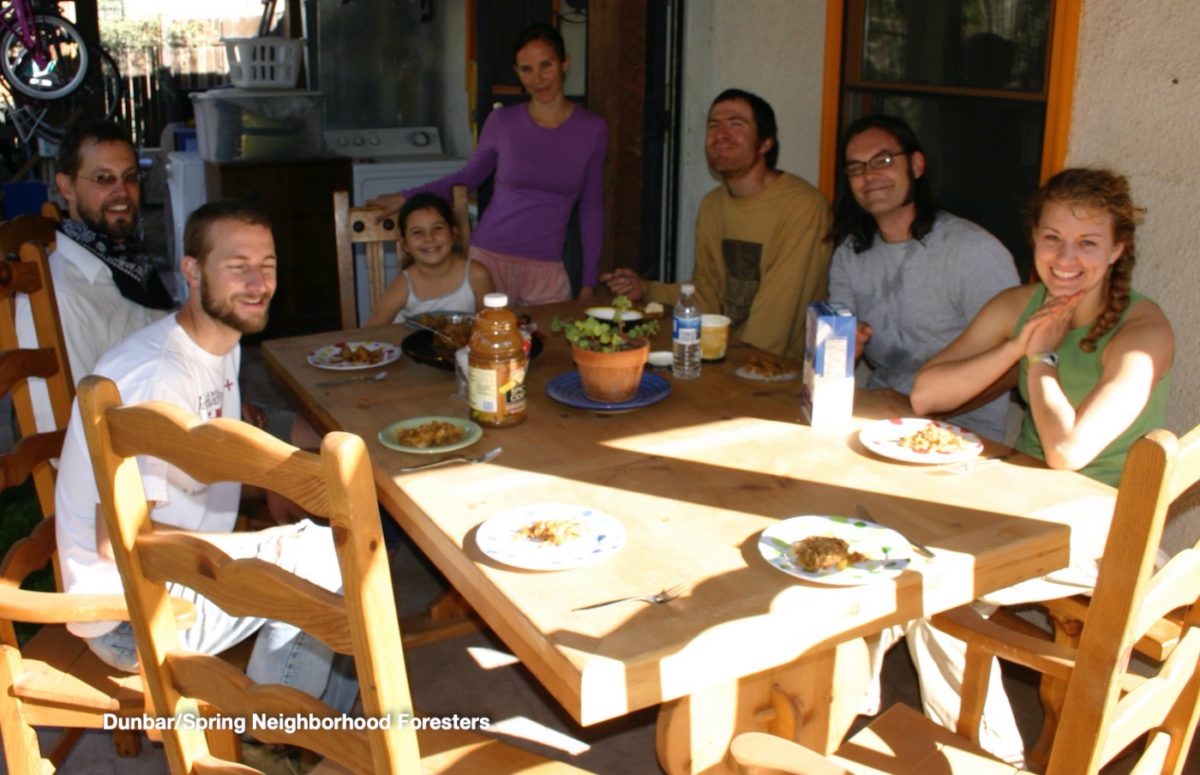
And you can begin by simply waving or saying hello when you see your neighbors, introducing yourself, or even organizing a pot luck or other gathering where you could discuss each other’s visions/hopes for the neighborhood, or planning a planting. Even just coordinating with one or two neighbors is a great start. If you are ready to reach out even further beyond your current circle of known neighbors, you could post a flyer, or write an announcement in your neighborhood newsletter or list serve.
You can begin with the planting of just one tree
Planting just one tree where there was none will make a big difference. It immediately shows that someone cares. And things just get better as the tree(s) grows, flowers, fruits, and attracts more life.
You could plant this first tree by yourself, though even better if you plant with someone else. That way you BOTH will literally set, and deepen, roots in your neighborhood’s ground. And those that help plant a tree are more likely to help care for it over time.
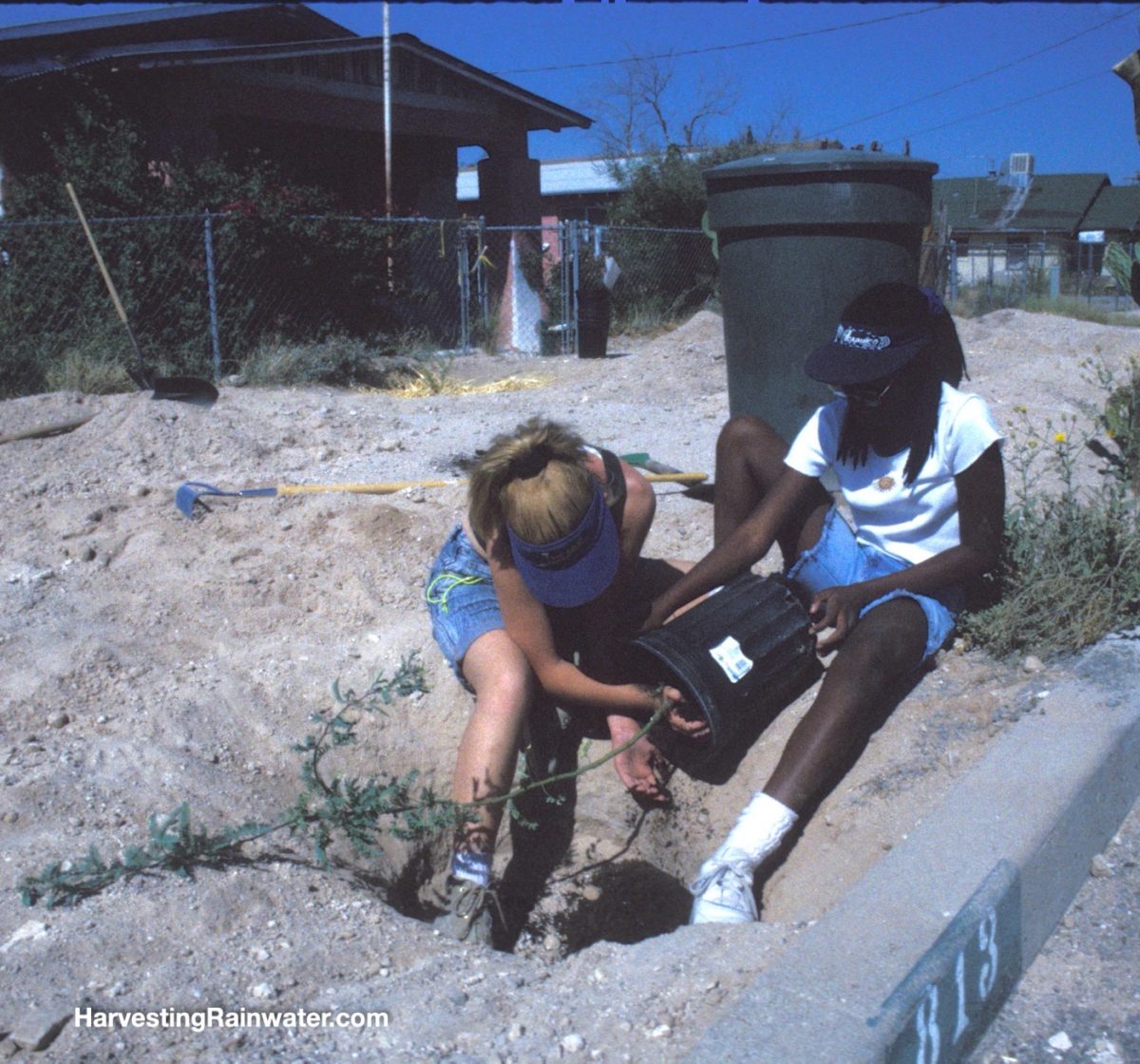
Reproduced with permission from “Rainwater Harvesting for Drylands and Beyond, Volume 2, 2nd Edition” by Brad Lancaster
With each successful planting, it gets easier to attract more planters, because they see what you are talking about. The living example grows. And if a planting does not succeed, reassess, rework your approach (maybe just try a different tree species, or a different time/day of the week for planting) and try again.
3. Planting a native tree(s) and understory planting(s)
Native plants are indigenous to, and best adapted to, your climate, soils, and wildlife as they’ve co-evolved over millennia—thus chances of the tree living a long and healthy life without excessive care or cost are typically best when you plant a native, as opposed to an exotic tree better suited, and indigenous to, a different region/climate.
Your chances of success are greater still when you plant a native that naturally grows in a similar microclimate as your planting spot. So, along your street a hardy, lower-water-use native mesquite tree that naturally grows in hot, dry areas that get a good brief gush of water in a storm would be a better choice than a less-hardy higher-water-use ash tree, which naturally grows along creeks that flow all year long.
By utilizing such native plants, the Dunbar/Spring Neighborhood Foresters efforts have experienced a dramatic increase in long-term success.
For example, 20 years after a year 1985 planting of over 100 non-native South-American hybrid mesquite trees in the Dunbar/Spring neighborhood — over 80% of the trees had died or been removed due to blowing over in storms.
While 20 years after a year 1996 planting of over 200 native trees — over 90% of the trees were alive and thriving.
This applies to more than just trees. In a healthy natural environment you typically find many understory plants growing under and around the sheltering canopy of trees, rather than a lone tree without life below it. Mimic what works in the wild by planting the same understory plant species under and around your native tree in the city. This dramatically increases the wildlife habitat, erosion-controlling and cooling/shading groundcover, production, and more.
4. Select native plants with multiple-uses and benefits
Select native plants that produce food, medicine, livestock fodder, dyes, fiber, building materials, superior native pollinator habitat, and more. This way your neighborhood forest also becomes a living pantry, pharmacy, feed store, crafts supplier, hardware center, wildlife sanctuary, and more.
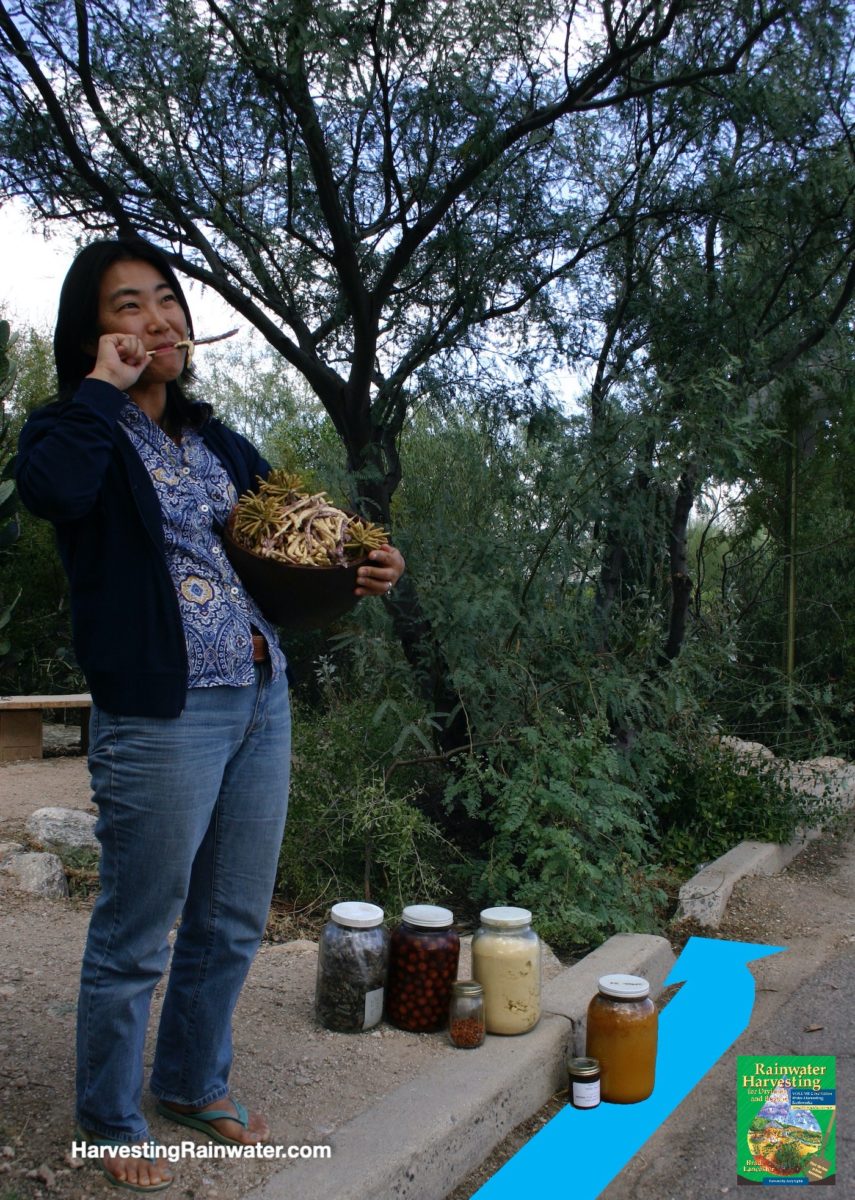
Seed pods from the tree are tasty to chew on, make drinks, or grind into flour. Neighborhood cholla buds, olives, chiltepines, mesquite flour, prickly pear jam, and honey sit on the ground near the curb cut that allows street runoff to passively irrigate food-bearing plants in the right-of-way.
Reproduced with permission from “Rainwater Harvesting for Drylands and Beyond, Volume 2, 2nd Edition”
Each use of a plant is an invitation to relate to that plant on yet another level. For example, I long saw cholla cactus just as plants I had to avoid due to their abundant thorns. But once I learned how to harvest, process, and enjoy their delicious and nutritious flower buds I saw the cholla cactus and its buds as a truly local culinary delight that required no supplemental irrigation. Then I learned how the cholla buds and many other native desert foods slow the body’s intake of sugars, which helps ward off diabetes and other illnesses—and I saw the cholla cactus as an essential partner in good health. And as I picked cholla buds every April, I observed the abundant wildlife dependent upon the cholla, such as the many native pollinators that visit the cholla’s flowers, like delightfully cute native solitary bees that sleep in the flowers as they close up at night, being tucked in like a loved one under a blanket. The cholla is also an ideal native bird nesting site in the urban environment since house cats won’t climb up a cholla cactus. And with so many different colors of flowers the staghorn cholla (Optuntia versicolor) is like a true desert rose. And I now harvest, plant, mark, and share cuttings from different cholla—each having its own distinct and radiant flower color. So the cholla population and harvest grows, as it has transformed in my mind and actions from a plant I avoid to one I seek out and collaborate with.
Similarly, harvesting pods from my native mesquite trees, I discovered that native birds will select the trees with the sweetest pods, then strip off strands of those pods to eat—leaving shreddy-looking pods that I can still harvest. So, these native birds lead me to the tastiest trees (every mesquite tree produces pods with a flavor unique to that tree). The birds also taught me to break up the pods into smaller pieces for my chickens. My chickens wouldn’t touch the whole pods, but once broken up in smaller pieces they can fit in their mouth—my chickens love the mesquite pods. Dogs, horses, and goats will readily eat the pods whole.
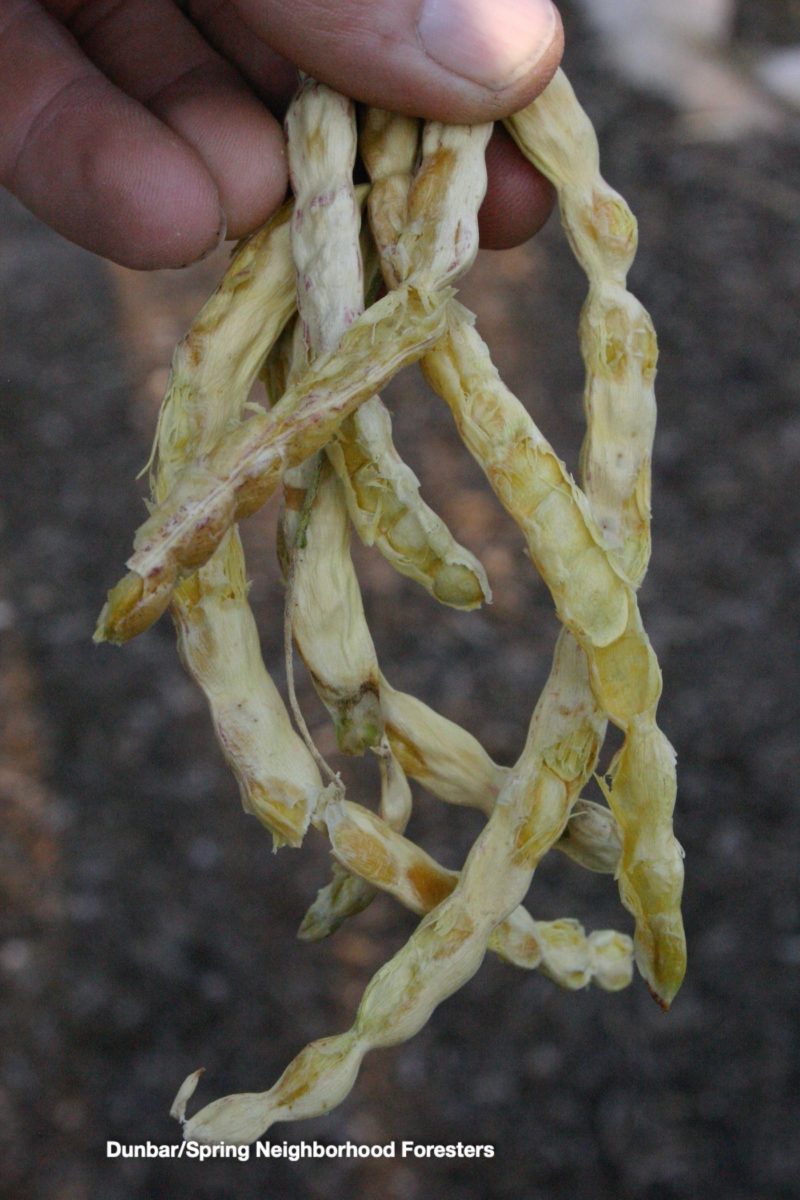
And I found that the mesquite trees with the best tasting pods tend to also have the best tasting sap, which I’ll suck on like desert candy, or better still—which I’ll use as a cough drop. I’ve found the dried sap to be far superior to manufactured cough drops when it comes to reducing throat irritation, stopping a cough, and calming a sore throat.
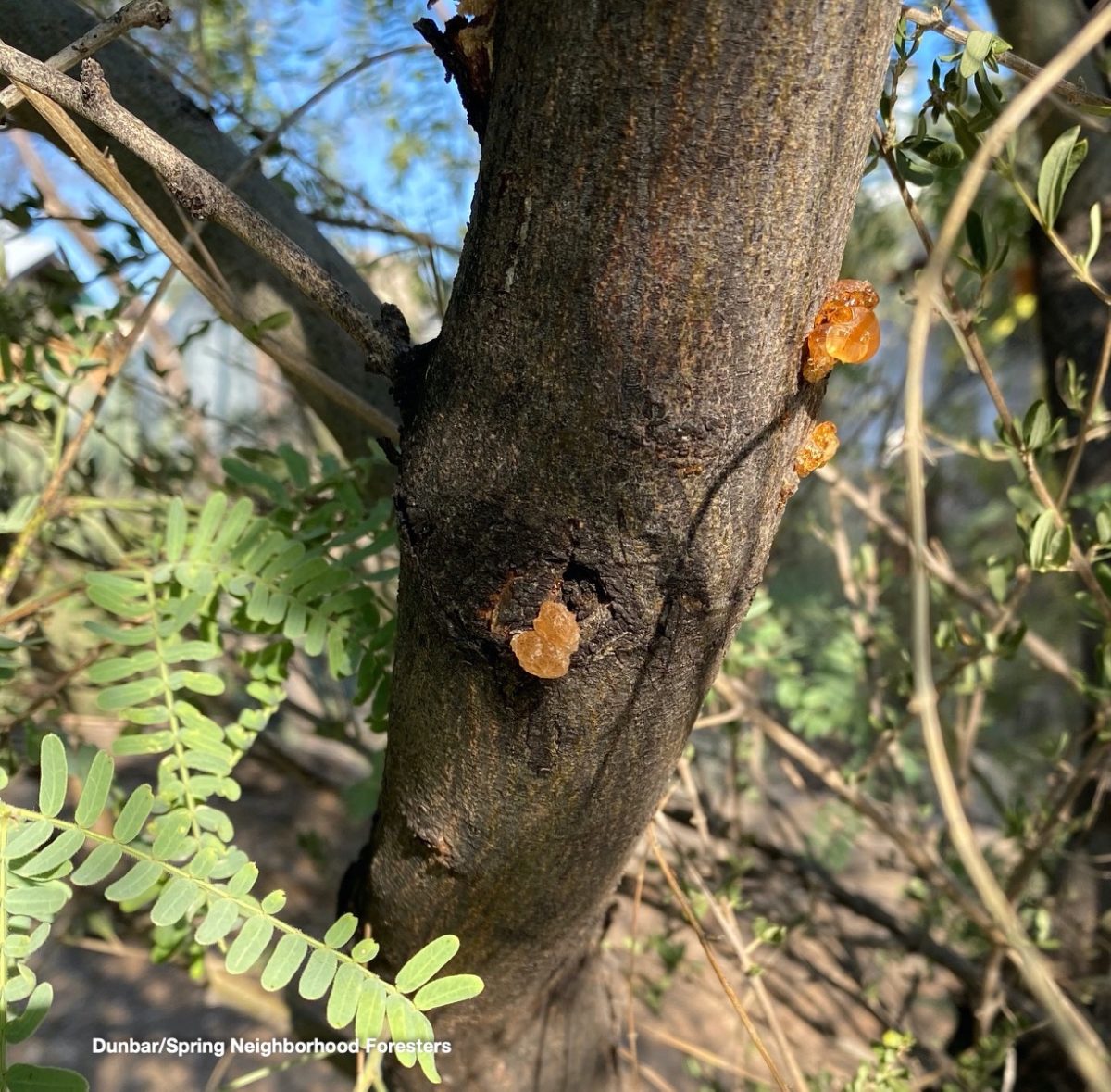
You can look to local ethnobotanical resources such as Desert Harvesters’ Eat Mesquite and More: A Cookbook of Sonoran Desert Foods and Living, workshops, and inquire at local native plant nurseries for more info on such potential.
5. Plant the rain (and fertility) before you plant the plant
Give back more water to the watershed, aquifers, and surface waters than you take from them, so the hydrology and life get better with time, not worse. Instead of using pumped municipal or well water as your primary or sole irrigation source, use rainwater and stormwater as your primary or sole irrigation source once your plantings are established (establishment period is typically 1-3 years of supplemental irrigation after planting). Set yourself up for success from the very start by planting the rain by planting your vegetation within or beside water-harvesting rain gardens or earthworks. Instead of putting in lots of expensive, leak-prone plastic irrigation pipe, you just move some dirt (then water with a hose, irrigation bucket, or water truck/trailer for the first 1-3 years). After that, the rain takes over.
With this simple strategy you can increase available rainfall by three times or more, since the rainwater will capture direct rainfall plus runoff from adjoining hardscape surfaces like streets and walkways. You then efficiently infiltrate and reinvest the rainfall, rather than wastefully draining it away.
We’ve found such planting of the rain before we plant our plants has increased the long-term success of such plantings by over 50% in the Dunbar/Spring neighborhood. Because if someone stops watering the plant, it will still get more water naturally. And the plants with water harvesting grow bigger, faster, and more robustly than those without.
Such water harvesting also reduces downstream flooding, and increases soil fertility and life…
6. Leaves are called leaves because we are supposed to leave them.
Rather than strip mining nutrients from our soils and plantings by raking up fallen leaves and throwing them away, we leave them on site (though we may sweep them off patios to adjoining sunken basins). Similarly, we mulch the surface of our soils (especially within water-harvesting basins) with our cut-up prunings. “Wastes” turned into resources in the form of absorptive, filtering, water-conserving mulch. And since more moisture collects and lingers in these basins and their mulch, the organic matter more quickly decomposes into fertile soil, while the moisture in the soil allows for easy exchange & sharing of nutrients.
Note: Cut-up prunings used as mulch should be cut down to 6-inch or shorter pieces to maximize soil contact and decomposition. Larger pieces are not mulch, they are brush piles, and susceptible to fire, neighbor complaints, and citations from the city. The elevation of a mulch’s surface within a basin should never be higher than elevation of the water inlet into the basin, otherwise the mulch could block the in-flow and capture of that water.
Research has found that vegetated street-side infiltration basins or rain gardens harvesting street runoff when mulched with organic material (such as leaves, and cut up prunings) had twice as much soil moisture, more soil life, and a greater ability to bioremediate (naturally filter) toxins as basins mulched with rock or gravel.1
1. Pavao-Zuckerman, M.A., and Sookhdeo, C., “Nematode Community Response to Green Infrastructure Design in a Semi-Arid City.” Journal of Environmental Quality 46(3):687-694 (2017).
7. Enhance public access to and through the growing neighborhood forest(s)
Plants are purposefully placed where they will shade and shelter the maximum area of public footpaths and streets, while maintaining a continuous pedestrian path throughout the forest that is safely/physically separated from the street. To maximize the accessibility and lure to the path and forest, the path is made and kept clear to a minimum 5-foot width and 7-foot height so all can comfortably walk or wheel along the path, especially two side-by-side without bending or ducking. Loose gravel, rock, or other materials that inhibit easy walking and wheeling are prohibited and/or removed. See here for a number of our efforts, including before and after photos, Enhancing Pedestrian Access.
Wildlife corridors are simultaneously created, regenerated, and expanded along with the growing pedestrian corridors and bicycle boulevards as the neighborhood forest grows, lengthens, and connects as it is planted to run along the neighborhood’s various streets. The expansion multiplies as one neighborhood’s forest is connected to another neighborhood’s; and/or to a natural waterway such as an arroyo, wash, or river; and/or to natural preserves such as the Tucson Mountain Park, the Saguaro National Park, and/or a State or National Forest. Thus, the trailhead is brought to everyone’s front door.
Health improves as walking, biking, and wheeling in these forested corridors is more enjoyable and comfortable. And the health and vitality of the corridors improves as they are also water corridors thanks to the water being harvested off the paths and parallel streets, to freely irrigate their sheltering vegetation.
We make our educational signage (describing these Neighborhood Forestery actions) multi-lingual for greater cultural, social, and knowledge cross-pollinization.
And we encourage and talk up strategies—such as replacing solid front yard fences or walls that block views—that allow for more friendly eyes on the street and invite community interaction—such as a visually porous or low fence & a front porch, rather than a closed garage door, that visually connects those on the front porch with those on the street.
For tips and guides on how we organize aspects of our annual Rain, Tree, & Understory Plantings see the links:
• Example lists of planting sites and work
• Example permit for neighborhood planting
• Maintenance/stewarding agreement for neighborhood plantings
• Organizing a neighborhood planting
